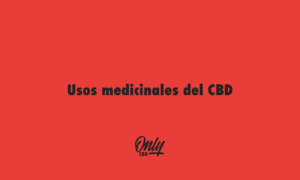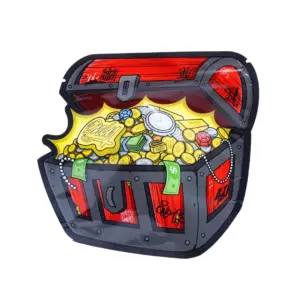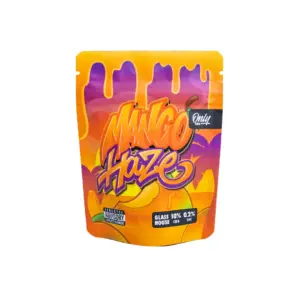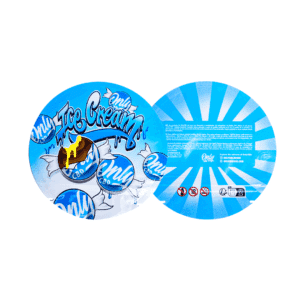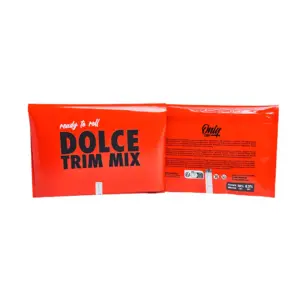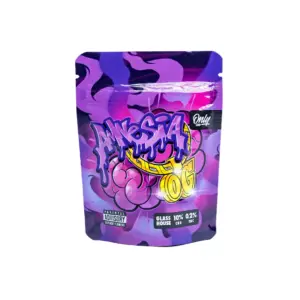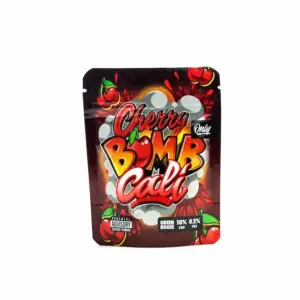Martin Lee's article for High Times magazine highlights groundbreaking research on CBD and how it has revolutionized the history of cannabis as a medicine.
“This changes everything!” That was Bay Area journalist Fred Gardner’s immediate reaction when he was in Steep Hill’s Oakland lab office and saw a chromosomal analysis showing the unusual cannabinoid content of a previously unknown marijuana strain. The year was 2009, and the strain of interest, an oddity called Soma A-Plus, didn’t rank high in THC (tetrahydrocannabinol) content, known as The High Causer*, unlike several thousand bud samples Steep Hill had previously tested for California dispensaries and medical marijuana growers.
Soma A-Plus was the first of a handful of soon-to-be-discovered cannabis strains that contained significant amounts of cannabidiol (CBD), a compound with intriguing medical attributes. One of these strains, Women's Collective Stinky Purple, broke records nearing 10 percent CBD by dry weight with very little THC. This genetic anomaly wasn't hemp—it was a drug plant, a high-resin, CBD-rich marijuana strain brimming with sticky medicine. But anyone who smokes it or consumes it as an edible won't get high because CBD isn't psychoactive like THC. CBD can actually reduce or neutralize the THC high depending on the amount of each compound in a given strain or product.
Traditionally, cannabis grown for hashish contains roughly equal amounts of THC and CBD. Since the late 1970s, however, cannabis genetics have shifted as renegade growers in Northern California have catered to consumer demand for THC-dominant strains. Consequently, CBD has nearly vanished from the gene pool in the Emerald Triangle, North America's cannabis breadbasket.
When Californians passed Proposition 215, the state ballot measure that legalized cannabis for medicinal use, few people knew about CBD. It wasn't on anyone's radar, except for a small group of pioneering scientists who were exploring the molecular mechanisms and healing potential of marijuana. Initial studies indicated that CBD had remarkable anti-inflammatory, antitumor, antipsychotic, and anticonvulsant properties with no known adverse side effects.
Fred Gardner had been covering the scientific history of CBD for O'Shaughnessy's, the Journal of Cannabis in Clinical Practice. In 2010, he and I launched Project CBD, a nonprofit educational project reporting on the entire CBD phenomenon—the research, the patients, the doctors, new strains and products, the business possibilities. From the beginning, we felt that CBD could be pivotal to the medical marijuana movement. We thought it might hold the key to freeing marijuana from the confines of the drug-abuse paradigm. How could the convoluted logic of the Drug Czar's office justify the ongoing prohibition of CBD-rich cannabis, a safe medicinal substance with no adverse side effects and that doesn't even get high?
The emergence of CBD-containing products meant that a larger number of people—including those not looking to get high—would be open to using marijuana for health reasons. Not everyone enjoys the high of THC; some people get jittery or anxious when using weed. CBD-rich cannabis may be the answer for those who want to experience the health benefits of marijuana without getting high. We refer to it as “high CBD” cannabis (as opposed to “high CBD”) to steer clear of recreational connotations—and this designation has since been adopted by medical scientists in peer-reviewed publications.
A TURNING POINT
The unexpected rediscovery of CBD in Northern California would upset everyone – THC users and police officers alike – and ushered in a new era in cannabis therapeutics. The crucial turning point came in the summer of 2013, when CNN broadcast a Sanjay Gupta's special on medical marijuana which featured the now famous case of Charlotte Figi, a little girl from Colorado who suffered from Dravet Syndrome.
Little Charlotte was having hundreds of seizures a week, and pharmacists weren't helping. Her parents thought they'd tried every option when they heard about a child with Dravet syndrome in California who responded well to CBD-rich cannabis oil. They found a high-CBD/low-THC strain at a Colorado cannabis dispensary, and it worked like magic for their daughter, reducing the seizures to a couple of times a month. That strain is now named Charlotte's Web in her honor.
Suddenly, the CBD genie was out of the bottle. National television audiences were shocked by what they were seeing and hearing: marijuana, once maligned as a “youth killer,” could save the lives of desperately ill children. What's more, children and adults don't have to get high to get better if they use medical marijuana. The idea that it might be possible to access marijuana's therapeutic side without the euphoria or dysphoria would have been irresistible to many after the CNN special.
But along with a growing awareness of cannabidiol as a potential health aid, there has also been a proliferation of misunderstandings about CBD-rich cannabis, a remarkable plant that befriended humanity before the written word. Cannabis has a rich history as a source of fiber, food, and medicine in different countries dating back thousands of years. But our ancient connection to this plant, and our knowledge of its usefulness as a versatile traditional medicine, was severed with marijuana prohibition. So, we've had to recreate a connection with cannabis and relearn how to use it for its maximum therapeutic benefit.
Some may wonder: Why not just light a joint and inhale? This seems to do the trick for many people. In fact, it's become much more complicated now that there are potent cannabinoid extract oils with different ratios of THC and CBD to choose from and various ways to administer them. The question of how to harness the healing qualities of cannabis is still a work in progress. It's the driving force behind a large laboratory experiment in democracy known as medical marijuana that has been unfolding state by state in recent years in the United States.
THE GREAT BREAKTHROUGH
For a long time, the illegality of marijuana has acted as a deterrent to scientific research in the United States. Ironically, it was President Ronald Reagan who advanced our understanding of the scientific basis for cannabis therapeutics when he escalated and militarized the War on Drugs in 1980. The Reagan administration invested tens of millions of dollars in research to prove once and for all that marijuana damaged the brain—or so they thought. It was, after all, the Evil Weed, and it was an institutional act of faith in the War on Drugs that smoking marijuana caused brain damage.
But beyond demonstrating how marijuana damaged the brain, the Reagan administration ultimately funded a series of studies that culminated in the discovery of the "Endocannabinoid System," which actually protects the brain when activated by plant cannabinoids like THC and CBD. This major scientific discovery opened up a wealth of new perspectives for understanding human biology and went a long way toward explaining how and why cannabis is such a multifaceted medicine—and why it's the most popular illicit herb on the planet.
By the mid-1990s, the endocannabinoid system had emerged as a hot topic among scientists around the world, who shared their findings in highly technical, peer-reviewed journals and at annual meetings of the newly formed International Cannabinoid Research Society. This was followed by a flood of scientific data affirming the astonishing therapeutic potential of CBD and other cannabinoid compounds.
A 1998 preclinical study funded by the National Institutes of Health was the basis for a U.S. government patent on the antioxidant and neuroprotective properties of CBD and THC, which were found to limit “neurological damage following ischemia, such as stroke and trauma.” Both compounds were described as having “particular application… in the treatment of neurodegenerative diseases such as Alzheimer’s disease, Parkinson’s disease, and HIV dementia.”
And that's just the beginning when it comes to cannabidiol. Some notable facts from the field of cannabis therapeutics:
- Cancer: Scientists at the California Pacific Medical Center demonstrated that CBD reduces breast cancer proliferation, invasion, and metastasis in experiments with human cell lines.
- Diabetes: Israeli researchers reported that CBD “reduces the incidence of diabetes in non-obese diabetic mice.
- Epilepsy: British scientists have discovered that CBD exerts anticonvulsant effects in animal models of epilepsy.
- Mood disorders: Brazilian researchers explored CBD's antipsychotic potential and anxiolytic properties.
- Acne: He Journal of Clinical Investigation (2014) reports that “CBD has potential as a promising therapeutic agent in the treatment of acne vulgaris.”
- Cardiac arrhythmias: He British Journal of Pharmacology (2010) revealed that CBD suppresses cardiac arrhythmias induced by infarcts in animals and reduces the proportion of brain damage.
- Stem cell neurogenesis: German scientists have discovered that CBD stimulates the growth of new brain cells in adult mammals.
- Antibacterial: According to the Journal of Natural Products (2008) published by the American Chemical Society, CBD “demonstrated potent activity against a wide variety of methicillin-resistant staphylococcus (MRSA) strains.” The World Health Organization has identified antibiotic-resistant bacteria as a major global health crisis.
- Mad cow disease: There is no known cure for mad cow disease, a deadly infectious brain disease transmitted by amorphous proteins called “prions,” but French scientists reported in the Journal of Neuroscience that “CBD can protect neurons against multiple molecular and cellular factors related to the different stages of the neurodegenerative process that occur during prion infection.”
THE POWER COUPLE: CBD AND THC
There is a lot of excitement surrounding cannabidiol—with good reason. So far, however, clinical trials that can “prove” CBD’s therapeutic utility have received little attention in the United States due to the war on drugs. Consequently, much of what scientists know about CBD is based primarily on preclinical studies—animal studies, molecular tests, test-tube experiments, etc.—and not on human studies. Some of this research has provided important insights into the endocannabinoid system and its crucial role in health and disease. But data from animal models are not always applicable to humans.
Outside the United States, CBD-rich remedies have been the subject of rigorous clinical trials and approved for therapeutic use in more than a dozen countries: Sativex, a sublingual cannabis spray containing equal amounts of CBD and THC, is available by prescription (though not yet in the U.S.) for the treatment of neuropathic pain and spasms associated with multiple sclerosis. GW Pharmaceuticals, the British firm that produces Sativex, determined that a combination of CBD and THC is more effective than either compound alone for pain management.
Simply put, CBD and THC are the power couple of cannabis therapeutics; they work best together. CBD and THC amplify each other's healing properties through the activation of different receptors in the brain. This synergistic dynamic is of great importance for medicinal patients. This is why THC is key to maximizing the therapeutic potential of CBD, and vice versa.
Concentrated cannabis oils with varying CBD:THC ratios are available at medical marijuana dispensaries, allowing patients to adjust or eliminate the psychoactive effects according to their needs. When present in roughly equal amounts in a cannabis strain or product, CBD will prolong the THC buzz while lowering THC's threshold for psychoactivity. Currently, cannabis patients also have the option of healing without the high by using a CBD product with only a small amount of THC. But a low-THC oil or flower, while non-intoxicating, is not necessarily the best treatment modality.
Each person's sensitivity to THC is the most important factor in determining the optimal ratio and dosage of a CBD-rich medicine. No single ratio or dosage is right for everyone. Cannabis therapeutics is personalized medicine. Patients may need to experiment, fine-tune, and, if necessary, adjust their treatment regimen until they find their own sweet spot with the correct balance of CBD and THC. Essentially, the goal is to administer consistent, known doses of a CBD-rich medicine that includes as much THC as the person can handle.
If you're lucky enough to live in a state with a robust medical marijuana program, there are plenty of options if you want to use CBD-rich cannabis without smoking it. CBD-rich cannabis—like the kind that gets you high—comes in many non-smokable forms: edibles, tablets, beverages, gel capsules, sublingual sprays, tinctures, topical ointments, transdermal patches, suppositories, and more. All of these options can be confusing, especially for those new to cannabis.
Product safety is a major concern given the poorly regulated marijuana industry. Unfortunately, many cannabis growers use dubious pesticides and hormone enhancers to increase cannabinoid content and crop yields. Look for CBD-rich products that are lab-tested and verified to be free of mold, pesticides, solvent residues, and other contaminants. If possible, avoid cannabis oils extracted with butane, hexane, and other toxic solvents; opt for safer extraction methods such as food-grade ethanol or supercritical CO2. A high-quality CBD product should include only high-quality ingredients: no corn syrup, trans fats, preservatives, or other artificial additives. Products should have clear labels showing the amount of CBD and THC per dose. Keep in mind that the CBD:THC ratio is not an indication of the amount of each compound in the product.
INDUSTRIAL HEMP:
What about CBD oil extracted from industrial hemp? Internet retailers are selling unregulated CBD products extracted from hemp in all 50 states, despite the fact that cannabidiol is not an FDA-approved dietary supplement. For many people, particularly those living in states where medical marijuana is not yet legal, hemp-derived CBD may be the only practical option for now, even though it is still technically a Schedule 1 controlled substance.
The federal government arbitrarily defines hemp—as distinct from marijuana—as a cannabis plant with 0.3 percent THC or less. What actually differentiates hemp from marijuana is resin content: Hemp is low-resin cannabis; marijuana is high-resin cannabis. Both CBD and THC are contained in the resin. High-resin drug plants include euphoric plants rich in THC and non-euphoric plants rich in CBD (as well as various combinations of the two).
Industrial hemp, low in resin, It is not an optimal source of CBD-rich oil.Hemp fiber is basically useless for extracting CBD because there is very little resin in the stalks. The sparse foliage of industrial hemp grown for nutritious seed oils (and other uses) reaches a maximum of 3.5 % of CBD by dry weight, but there is no CBD or THC in the seeds themselves. Compare this to ACDC, a non-euphoric, high-resin marijuana strain widely grown in California that contains 20% of CBD by dry weight.
The legal limit of 0.3 % THC for industrial hemp is impractical, a scientifically unfounded distinction designed to maintain marijuana prohibition. In an effort to circumvent the law, some growers in Colorado and other states are cultivating marijuana high in CBD-rich resin and calling it hemp, harvesting their crops early to minimize the amount of THC. Growing industrial hemp outside of the strict, state-mandated parameters for pilot scientific research is still federally prohibited.
For foreign hemp growers, CBD paste is typically a byproduct of industrial hemp grown for other purposes. Farmers sell surplus hemp biomass to merchants who extract CBD oil. This is not a good starting material for preparing CBD products because large quantities of low-resin hemp are required to extract a small amount of CBD. The more plant material used for extraction, the greater the risk of contaminants because hemp is a bioaccumulator that absorbs toxins from the soilThat's a great trait for clearing poisoned environments—hemp was planted near Chernobyl after the nuclear disaster for this purpose—but it's exactly what you don't want in a medicine.
Furthermore, CBD commerce is proliferating online with very little interference from the federal government beyond FDA warning notices targeting hemp oil sellers for mislabeling their products and making unproven medical claims. Some CBD products tested by the FDA have little or no CBD. Even more disconcerting is what is actually found in these items. Many, if not most, vape cartridges containing CBD hemp oil contain propylene glycol, a thinning agent that is carcinogenic when heated and inhaled. Flavoring agents are also commonly included in CBD hemp oil cartridges, although few of these ingestible food additives have been tested as safe for inhalation. Some are known to be toxic.
You might find helpful products among those offered as CBD hemp oil if you have the confidence to experiment with the vagaries of online medications. It's a poor choice, but some of these products may provide health benefits. Low-THC cannabis oil extracts have been a miracle worker for a number of children with intractable seizure disorders. There are reports of epileptic children experiencing near-complete seizure suppression when using CBD oil products. But for many other seizure disorder patients, both adults and children, CBD doesn't seem to work its magic. It's not a miracle cure for everyone.
The therapeutic range of hemp CBD oil is significantly limited by the low amount of THC and other cannabinoids it contains. Many medical marijuana patients have learned through trial and error that augmenting CBD-rich oil by adding THC or THCA—the unheated, non-psychoactive form of THC present in raw cannabis flowers and leaves—helps keep seizures and other symptoms at bay. Low-THC cannabis oil products don't seem to work for everyone. People of all ages need access to a broad spectrum of whole-plant remedies, not just low-THC oils.
THE MOLECULE AGAINST THE PLANT
CBD will soon become a pharmaceutically isolated molecule. When Epidiolex, a nearly pure CBD anticonvulsant developed by GW Pharmaceuticals, receives the FDA's green light, cannabidiol will join the isolated THC molecule (Marinol) as a legally available prescription drug. But the cannabis plant itself will remain illegal for the foreseeable future. Imagine that!
Project CBD recognizes that an isolated CBD molecule is not the same as the whole CBD-rich cannabis plant, which includes hundreds of medicinally active components. Whether synthesized in a lab or harshly refined from industrial hemp paste, “pure CBD” products lack the full range of medicinal terpenes and minor phytocannabinoids found in marijuana. These compounds interact with CBD and THC to create what scientists describe as the “entourage effect,” so the therapeutic impact of the whole plant is greater than the sum of its parts.
It's not that an isolated molecule doesn't work – pure CBD can be helpful in certain cases, but the Whole plant CBD has a therapeutic window much broader than CBD as an isolate. This was highlighted in a 2015 experiment by Israeli scientists who found that isolated CBD required a much higher dose to be effective compared to a CBD-rich whole-plant oil. Furthermore, if one misses the mark slightly, either too low or too high, then the isolated CBD had a poor impact on pain and inflammation—unlike the CBD-rich whole-plant oil, which was effective at a lower, broader dosage range. Problematic interactions with other drugs are also more likely with high doses of isolated CBD. “The therapeutic synergy observed with plant extracts results in the requirement for a lower amount of active components, with a consequent reduction in adverse effects,” the Israeli researchers conclude. Other scientists have reported similar findings.
CBD is a powerful molecule, to be sure, but the whole plant is even more powerful.





